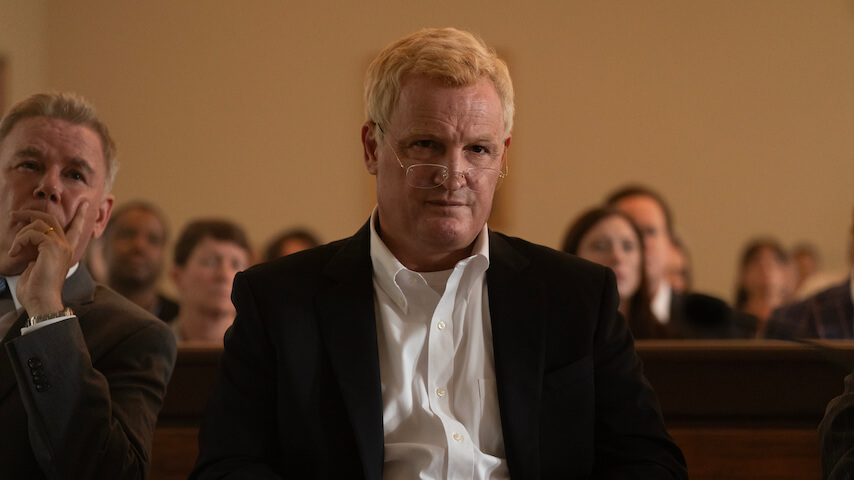A strange thing happens in the November 19 finale of Hulu’s limited series Murdaugh: Death In The Family. For seven episodes, audiences have watched as the Southern dynasty of the Murdaugh family, led by charismatic-to-a-fault lawyer Alex (Jason Clarke), has crumbled under the weight of one tragedy after another—almost all of them at his own hands.
Constantly, as the Murdaughs unravel, you are told of the myriad ways Alex has failed his family, his community, and himself. He’s addicted to opiates, he’s stealing money from his law firm and the clients he claims to care about, he’s had affairs, and he’s drinking himself into a stupor. It all culminates in the murder of his wife Maggie (Patricia Arquette) and their son Paul (Johnny Berchtold) on June 7, 2021. He was convicted of these acts in 2023, and they are believed to be his means of distracting the encroaching debts, lawsuits, and authorities at his doorstep.
But if you’ve followed this case since it first made headlines in 2019, when Paul’s reckless actions behind the wheel of a boat caused the death of teenager Mallory Beach, none of these revelations should be shocking. They were dug up and turned into bold-faced headlines in the lead-up to Alex’s trial. And yet, the finale will likely shake even the most well-researched viewer by doing something no other rendering of the Murdaugh saga has done: It finally puts the gun in Alex’s hand and, by doing so, puts this story to rest.
As the series, from co-creators Michael D. Fuller and Erin Lee Carr, comes to a close, Alex lies in his new forever home in prison and thinks back to the night of Maggie and Paul’s deaths. It is a scene the audience already watched play out in episode six. Maggie has come back to town after separating from Alex to be a support system as his father’s health fails. Slowly grappling with the guilt he feels for his role in Mallory’s death, Paul is trying to make good on his new turned leaf, while also realizing he is quickly becoming a mirror image of his father’s own recklessness. Mother and son go down to the dog kennels on a rather mundane chore that night and walk into a killer’s path. Originally, the person holding the gun isn’t seen, but when the finale returns to this moment, it plays out as prosecutors said it did: Alex was with his wife and son at the kennels when he stepped away, slipped on what was essentially a murder poncho, and pulled out two guns. First, he shot Paul, in the stomach and again in the head. Then, he shot Maggie in the leg, the arm, and put two bullets in her head. He strips off his blood-splattered covering and hides it in the woods, changes clothes, visits his dementia-riddled mother as an alibi, and then returns to the scene of the crime as if discovering it for the first time.
While graphic and brutal, it is hardly the most horrific murder scene on television in recent memory. But after nearly five years of nonstop coverage and a Greek chorus of amateur and professional investigators saying “he did it,” actually seeing Alex Murdaugh kill his wife and son, who recognize it’s him, is gutting (in part because of Arquette and Berchtold’s excellent performances). The whole scene is shocking and bloody—and yet it feels necessary in the context of this series. It’s the whole reason to make it because, god knows, audiences have already had every chance imaginable to learn the nitty-gritty facts of this case.
Just for reference, here are some of the documentaries made about the Murdaugh family: Netflix’s Murdaugh Murders: A Southern Scandal, a two-season series with a lot of access to the family and friends of those involved; HBO Max’s Low Country: The Murdaugh Dynasty; Investigation Discovery’s Murdaugh Murders: Deadly Dynasty (also on HBO Max); Dateline’s special, Murdaugh–Power, Privilege & Scandal; a two-part special of CNBC’s American Greed series on Alex’s financial crimes; and one-offs on ABC and CNN. Lifetime even celebrated its 500th movie milestone with a two-part event, Murdaugh Murders starring Bill Pullman as Alex. And then there’s South Carolina journalist Mandy Matney’s multi-year podcast on the case (the inspiration for this show), not to mention steady coverage from the likes of Nancy Grace.
This is all to say that this case is among the most exhaustively covered murders of this century. And Murdaugh: Death In The Family shows audiences what many of them believed from the jump: that Alex was a bad guy who made bad decisions and ultimately did the worst thing he could do by making his family pay for his sins. Saying that ad nauseam in TikTok explainer videos and on cable news is one thing, but actually watching it play out is a different kind of reckoning with the reality of this case.
With so much coverage of Alex, he can sometimes feel like a cartoon character or Southern stereotype, a red-faced, overweight, boisterous lawyer who speaks just to hear his own voice. So stripping him down, as expertly and immersively as Clarke did in the Hulu series, is an important reminder of who was really on trial. He wasn’t just the embodiment of power, money, privilege, greed, and all the other dirty words that fill the titles of the documentaries about his cautionary tale. At the end of the day, Alex was yet another killer who gunned down his own family to save himself.
Watching him do that sans the cheap grins and swaggering wobble is chilling. And it finally, after a library’s worth of cultural dissection, puts a period on this case—or at least tries to. Will this actually be the end of our cultural fascination with the Murdaughs? Probably not. There will always be new shows that think they know more than those that came before them. But for now, Fuller and Carr do what they set out to do. They told a definitive story of Alex Murdaugh (not of Mallory Beach, Stephen Smith, or Gloria Satterfield, all of whom died in and around the world of the Murdaughs). Rather, this is the story of Alex’s sins, the stolen lives of Maggie and Paul, and the faces he has to see at night when he closes his eyes. In fact, it’s the final image of Alex in the series that hits hardest: the man in the glass looking at the bloody mess he made of his life. And that’s the guy audiences need to see. It’s also the one true-crime obsessives can finally move on from.







































